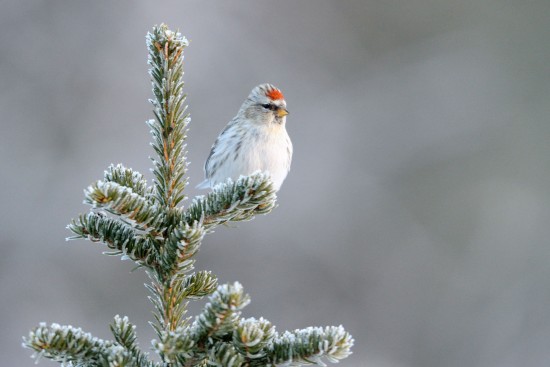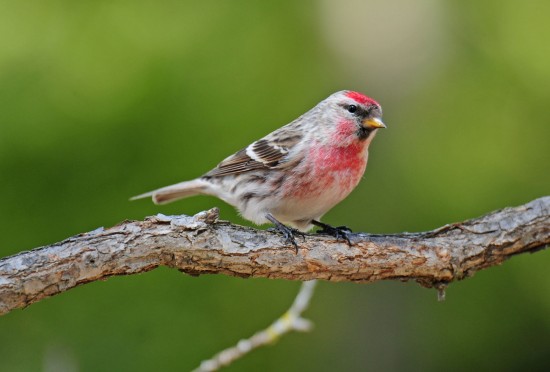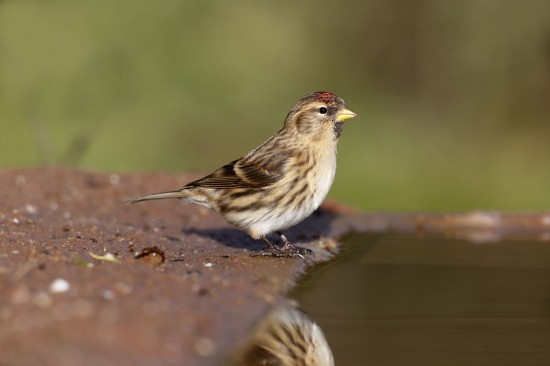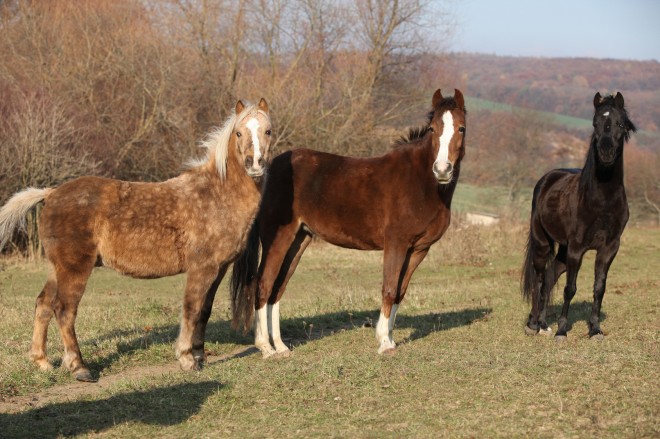



The Redpolls are a family of three species of finch that are in the Fringillidae family along with familiar faces such as the Greenfinch and Goldfinch. All feature the red markings on their head that gives them their name and all are birds that live and breed in the northern woodlands of Europe.
Their diet is a simple seed diet so a good British of Foreign finch mix will serve as a base. They will also enjoy seeds such as blue maw, white and brown perilla and niger seed in addition. Insect paste or live food will also be taken, especially around breeding time and grit or cuttlefish should always be available. They enjoy eggfood all year round and will also take weeds such as coltsfoot, dandelion, chickweed, sow thistle, sorrel and ragwort, though be careful where you source them from in case of spraying with chemicals.
Some people supplement their drinking water with carophyll red to bring out the natural colour in the head and breast, particularly if showing the bird.
The Arctic Redpoll (Carduelis hornemanni) is the least frequently seen of the three birds in aviculture in the UK. Their natural environment is the tundra birch forests of Greenland, Canada and Eurasia, where there are two subspecies depending on location. Some of the birds will remain in the same location while other migrate south for winter and mix with Common Redpolls.
They are generally paler than the Common Redpoll and have an unstreaked rump patch and pale vent area. The subspecies from Greenland is a large bird compared with the normal and is often yellower in the plumage than grey-brown, with orangish foreheads and light coloured stripes on the wings. Generally, birds are around 12-14cm in length and weigh around 12-16 grams.
In the wild, these birds breeding around May to July with the nest being built in a low tree or bush with twigs, then root fibres or fragments of bark and an inner layer of down and reindeer hair. They lay 3-7 eggs that are incubated by the female and hatch at around 11 days, fledging aged around 13 days.
The Common Redpoll (Carduelis flammea) in aviculture is known by the name of one of its subspecies: the Mealy Redpoll. It is the larger of the two commonly kept redpoll species. The three subspecies are spread across North America and Eurasia (Mealy), Iceland (Icelandic Redpoll), Greenland, and the Baffin Islands (Greenland Redpoll). All of the species migrate south but are very resistant to cold temperatures and the migration is more about food than cold.
The Common Redpoll is around 11.4-14cm in length with overall brown-grey feathers, dark streaks and the bright red patch on its forehead. Male birds sometimes have red on their breast and the rump is streaked. They have yellow beaks and brown legs.
Similar to the Arctic Redpoll, in the wild they build a nest low in a tree or bush. They use the same makeup of root fibres and bark with down and hair inside and lay 3-7 eggs. Hatching occurs at 11 days and fledging at 13 days after this.
The Lesser Redpoll (Carduelis flammaea cabaret) is the British species of the bird that is native to this country and was thought to be a subspecies of the Common Redpoll until recent times when it was realised to be a separate species.
This redpoll is around 11.5-12.5cm in length with a wingspan of 20-22.5cm and weighs around 9-12 grams. The male is brown with darker streaks, a red forehead and black chin, pink on the breast and also on the face. The flanks are buff colours with darker streaks and the belly is whitish. The female bird doesn’t have the pink on the breast and the streaks are less defined.
Redpolls bred in captivity have produced some notable mutations to the original colouring which can be extremely attractive including brown, Isabel, pastel and agate birds.
Originally, the bird was found in Great Britain, Ireland and the Alps but has widened its range to include central and northern European areas. In many countries, it nests along the North Sea coast, such as in France, Germany, Denmark, Norway and Sweden. It is also now found as far away as Poland, Slovakia and northern parts of Romania. It does migrate short distances in winter with alpine birds moving to lower altitudes and some of the British birds moving to mainland Europe. The species has also been introduced to New Zealand and is common on the South Island as well as many offshore islands and the Australian territory of Macquarie Island. Typically, it is a bird of open woodland, scrubland, dunes and even farmland and its spread has been aided by the planting of conifer woodland.
Both in the wild and in captivity, redpolls are social birds that live well in flocks and can mix with other types of birds. They pair up in late winter and pairs will often nest in colonies near each other. The female makes a cup-shaped nest in a shrub or tree using twigs and plant stems with grass, moss or leaves to line it. 2-7 eggs are laid which are incubated for 12-15 days while she is fed by her mate. The birds fledge from 9-15 days having been fed by both parents after hatching.
I personally have a pair of Mealy Redpolls and a cock Lesser and can recommend these birds. While they live happily in an outdoor aviary, they can also adapt to a large indoor cage if done from a young age and are fantastic characters to live with. They are curious birds who can overcome their natural fear of people with patience and can learn to come to the hand for food. Their song is not the most melodic but is pleasant and not as loud as many canaries or greenfinches so ideal for someone who is conscious of bird noise. They live well with others and are a pleasure to keep.
 Does Your Dog Run Up And Bark At Strangers?
Does Your Dog Run
Does Your Dog Run Up And Bark At Strangers?
Does Your Dog Run
 Positive Steps To Safeguarding Your Dog From Being Stolen
Positive Steps To
Positive Steps To Safeguarding Your Dog From Being Stolen
Positive Steps To
 Understanding The Pecking Order Of Horses
Understanding The
Understanding The Pecking Order Of Horses
Understanding The
 Teaching Your Dog Show Craft
Teaching Your Dog
Teaching Your Dog Show Craft
Teaching Your Dog
 11 Ways To Minimise Exposure To Environmental Allergens In Dogs
11 Ways To Minimi
11 Ways To Minimise Exposure To Environmental Allergens In Dogs
11 Ways To Minimi
Copyright © 2005-2016 Pet Information All Rights Reserved
Contact us: www162date@outlook.com